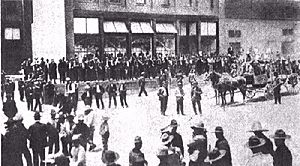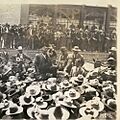Cananea strike facts for kids
The Cananea strike happened in June 1906 in the mining town of Cananea, Sonora, Mexico. It is also sometimes called the Cananea riot or massacre. Even though the workers had to go back to their jobs without getting what they asked for, this event was very important. It showed the growing unhappiness in Mexico during the last years of President Porfirio Díaz's rule. This unhappiness eventually led to the Mexican Revolution in 1910. During the strike, 23 people died, 22 were hurt, and more than 50 were arrested.
Quick facts for kids Cananea strike |
|
|---|---|
 Striking workers in Cananea confront American possemen protecting the company store. |
|
| Objective | Obtain better working conditions for Mexican employees at the Cananea mines. |
| Date | June 1, 1906 |
| Casualties | 23 killed 22 wounded |
Contents
The Cananea Copper Company
The Cananea Copper Company was started by an American businessman named William Cornell Greene in 1896. President Porfirio Díaz's government gave Greene special permission and help. This allowed Greene to build one of the most important mines in Mexico. He also gained control over land, farms, transportation, and lumber mills. This gave Greene a lot of power over a large part of Mexico and its workers. Many Mexicans felt that Díaz was giving too much control of Mexico's resources to foreign companies.
Life in Cananea in 1906
In 1906, Cananea was a "company town." This means the mining company owned most of the town, including homes and stores. About 23,000 people lived there. Most of them (21,000) were Mexican, and the rest were American. The main jobs at the Cananea Consolidated Copper Company were held by non-Mexicans. Many of these managers were friends of the company owner, William Greene, not trained professionals.
The company had its own police force to keep order. Relations between the company and its workers were often tense. The only place to buy food and other goods was the company store. Workers said the prices there were very high.
Why the Workers Went on Strike
By 1906, the Cananea Consolidated Copper Company employed about 5,360 Mexican workers. They worked in the copper mines and earned three and a half pesos per day. In contrast, the 2,200 American workers doing the same job earned five pesos. This difference in pay made the Mexican workers very unhappy.
American employees had already gone on strike against the company in 1903. This showed the Mexican workers that striking was a way to demand change. The working conditions for Mexican employees were very poor. During the Cinco de Mayo celebrations in 1906, Mexican workers openly shared their complaints. The local government then put the town under "martial law" to try and prevent problems. Martial law means the military takes control instead of the usual government.
The Strike Begins
On June 1, 1906, most of the Mexican miners went on strike. Their leaders were Juan José Ríos, Manuel Macario Diéguez, and Esteban Baca Calderón. They made several demands:
- A foreman named Luis should be removed.
- Workers should be paid five pesos for eight hours of work.
- Seventy-five percent of jobs should go to Mexicans and twenty-five percent to foreigners.
- Responsible and respectful people should operate the mine cages.
- All Mexican workers should be able to get promotions if they had the skills.
The company leaders said no to all these demands. So, the workers decided to march and gather more people from other towns nearby. The local people supported the workers, and the crowd grew to more than 3,000 people.
Clash and Violence
As the crowd marched past the company's wood shop, American employees in charge of that area, the Metcalf brothers, sprayed them with hoses. Then, they fired guns, killing three people. The angry crowd then set the building on fire, and four American workers inside died in the flames.
When the crowd moved toward the government building, they were met by about 275 armed Americans. This group was led by an Arizona Ranger, even though the Governor had told them not to get involved. More workers were killed, and the strike leaders were sent to prison. News reports at the time said that on June 1, strikers destroyed a lumber mill and killed two brothers who were defending the mine. Eleven Mexican "rioters" were reported dead.
About half of the company's private police force stayed out of the fight. The owner of the company, Colonel William Cornell Greene, sent a telegram asking for help. A group of 275 volunteers from towns in Arizona (Bisbee, Douglas, and Naco) came to Mexico. They were led by Captain Thomas H. Rynning of the Arizona Rangers. This was against the orders of the Governor of Arizona Territory.
The Governor of Sonora, Rafael Izabal, sent 40 "Rurales" (Mexican mounted police) from Hermosillo to help. Mexican "Federal troops" (national army soldiers) were also sent to Cananea. Four troops of the U.S. 5th Cavalry Regiment from Fort Huachuca were stopped at the border by order of President William Howard Taft.
A tense standoff happened between the striking miners and about 200 Americans. Many people had weapons, and shots were fired. Colonel Kosterlitsky, the Mexican commander, ordered the American volunteers to leave the town by train and go back across the border. Mexican Rurales and Federal soldiers then took away the strikers' weapons and made arrests.
What Happened After the Strike
Colonel Greene believed the strike was caused by a "Socialistic organization" that was against the Díaz government. Before the strike, a political group called the Partido Liberal Mexicano (PLM) had formed. This group had a lot of support and pushed for changes in factories and farms. PLM writings were found among workers at both the Cananea mine and another factory called Rio Blanco.
The leaders of the strike were arrested by Mexican authorities. They were sentenced to prison for up to fifteen years. They were finally released in May 1911, during the Mexican Revolution.
Even though the government forces had acted with some control, the fact that armed foreigners entered Mexican land made many Mexicans very angry at the Díaz government. Díaz had actually told Governor Izabal not to let Americans help restore order in Cananea, but his message arrived after the Arizona Rangers had already crossed the border.
The Cananea strike, along with the Río Blanco strike in January 1907, became symbols of how President Porfirio Díaz's government was seen as unfair, too friendly to foreign interests, and harsh on its own people. These events became well-known to many Mexicans.
However, the local impact in Cananea was also important. A new company manager, Dr. Louis D. Ricketts, was hired. He had a lot of mining experience and brought in better pay and work practices. By 1912, the number of foreign workers in the company had dropped to only 13% of the total. William Greene's personal way of running the company ended when a new group bought him out. This new group focused on making the mine more modern and efficient.
Cananea Today
A traditional Mexican song called a "corrido" was written in 1917 about the incident. It is titled "Cananea jail."
The Cananea municipal jail, built in 1903, is now a museum called the Workers' Struggle Museum. It shows photographs and tools used in mining.
The mine in Cananea is still used for copper today. Even after the original 1906 strike, the Cananea mine has often been a place of worker disagreements. The most recent major miners' strike happened in 2007–2008.
Images for kids
See also
 In Spanish: Huelga de Cananea para niños
In Spanish: Huelga de Cananea para niños




